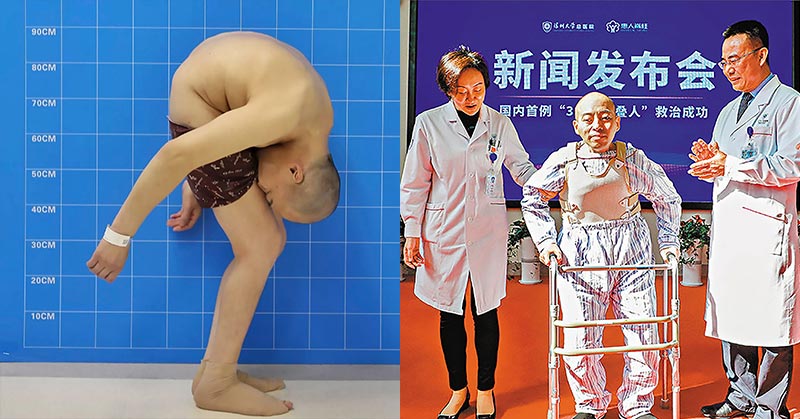A man in China has finally gotten his life back after receiving aggressive spinal surgery that has made it possible for him to stand up, lie down, and even to simply look straight ahead.
The Folding Man
46-year-old Li Hua was known as the “Folding Man”, because his entire upper body was folded onto his lower limbs in a permanent forward bend position. He was diagnosed with a form of arthritis called ankylosing spondylitis at the age of eighteen, but his family was unable to afford treatment [1].
Over the years, his painful joints made it increasingly difficult to remain upright, until he reached a point where he was unable to sit up or lie down, and struggled to eat or drink. He was refused medical treatment in his home province, Central China’s Hunan Province, on the grounds that it would be too dangerous and he would be risking his life [1].
Professor Tao Huiren, head of the spinal surgery and orthopaedics department at Shenzhen University General Hospital accepted the challenge. He had treated patients with this condition before, but none had been quite this severe [1].
“Our only option was to break his bones one section at a time – femur, cervical vertebrae, thoracic vertebrae, lumbar vertebrae – and then straighten his entire spinal column,” said Huiren. “The risks involved were 20 to 30 times that of a regular spinal surgery patient, and the chances of him becoming a paraplegic were also very high.” [1]
The surgery was a success, and now Hua is able to stand up, sit down, and lie flat for the first time in twenty eight years [1].
Ankylosing Spondylitis
Ankylosing spondylitis (AS) is a form of chronic arthritis that primarily affects the spine. It usually starts in adolescence or early adulthood and is characterized by back pain and stiffness. Gradually, the bones of the spine (the vertebrae) fuse together and back movement becomes very limited. This is called ankylosis [2].
AS starts in the joints between the pelvic bones (the ilia) and the base of the spine (the sacrum). These joints are called the sacroiliac joints. From here, the inflammation spreads through the rest of the vertebrae, causing a condition called spondylitis [2].
Other joints, such as the shoulders, hips, and occasionally the knees, can become involved as well, and eventually the disease can affect the joints between the spine and ribs. This can restrict the movement of the chest and make it difficult to breathe deeply [2].In some cases, AS can affect the eyes. This condition is known as iritis or uveitis [3].
How Does This Happen?
Scientists are still unsure how people end up with ankylosing spondylitis. The condition is not very common, however, and only affects about 0.2 to 0.5 percent of the population in the United States [4].
AS is thought to be an inherited condition, and there are some genetic markers that could make you more likely to develop the condition, specifically the HLA-B27 antigen [4]
HLA-B27
HLA-B27 are proteins called antigens. They are found on the surface of your white blood cells and help you to fight infections. If you have these antigens in your blood, it could mean that you have an autoimmune disease, which is when your immune system attacks your own cells [5].
Ankylosing spondylitis is one of the most common autoimmune diseases associated with HLA-B27, and can be detected by a simple blood test if your doctor suspects you have AS [4].
Are There Any Treatments For AS?
The primary goal of treatment is to relieve your pain and stiffness and to prevent your spine from deforming. The most successful treatments occur before irreversible damage has been done to the spine [6].
The first line of treatment against AS are Nonsteroidal anti-inflammatory drugs (NSAIDS). These can relieve inflammation in your joints, pain, and stiffness, but could cause gastrointestinal problems [6].
If NSAIDS don’t work, your doctor may prescribe a biological medication. Examples of these are tumor necrosis factor (TNF) blockers, or interleukin-17 (IL-17) inhibitors. Both of these drugs play a role in inflammation and help reduce pain, stiffness, and tender or swollen joints [6].
Physical therapy is also an important factor in treatment, and can provide a number of benefits including pain relief and improved strength and flexibility [6].
Surgery is a last resort, and is typically reserved for patients who have severe joint damage. Most people with AS do not need to have surgery [6].
A Successful Surgery
Li Hua’s surgery was highly successful, and this was the first time such severe spinal deformities were corrected in China. Hua is currently using a walker to assist normal movement, but doctors say that with a few months of physical therapy her will be able to move around as normal [1].
“Of course he won’t be able to do anything too extreme like boxing or playing tennis, but all regular bodily movements will not be a problem.” [1]
The surgery has given him his life back, and he wants everyone to know how grateful he his firstly to his mother, who had been his primary caregiver for the majority of his life, and of course to Dr. Tao.”There would’ve been no cure for me without Doctor Tao. He’s my saviour, and my gratitude to him is second only to my mother.” [1]
Editor’s Note: This article was originally published in August 2020 and has since been updated.
Sources
- https://www.ladbible.com/news/weird-man-folded-in-half-stands-straight-after-28-years-20191216?fbclid=IwAR0lcM47nj6wVKiJnf5w5w7crN32LypjBZl2WXhINFDfFAEkxIyglDKuPSs
- https://ghr.nlm.nih.gov/condition/ankylosing-spondylitis
- https://www.spondylitis.org/Ankylosing-Spondylitis
- https://www.hopkinsarthritis.org/arthritis-info/ankylosing-spondylitis/
- https://www.urmc.rochester.edu/encyclopedia/content.aspx?contenttypeid=167&contentid=hla_b27_antigen
- https://www.mayoclinic.org/diseases-conditions/ankylosing-spondylitis/diagnosis-treatment/drc-20354813

